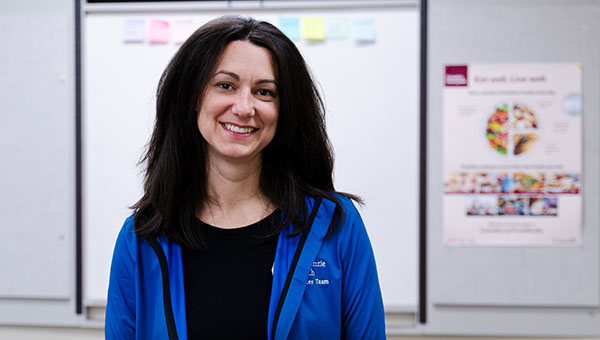From patient to diabetes educator at Mackenzie Health’s Diabetes Education Centre – This is Sarah’s story
 At only 19, Sarah was diagnosed with diabetes. If you ask Sarah, it wasn’t research or family history that prompted her to get checked. In fact, it was her cat, who was diagnosed with diabetes three months earlier, and the symptoms she displayed that spurred Sarah to pay her family doctor a visit.
At only 19, Sarah was diagnosed with diabetes. If you ask Sarah, it wasn’t research or family history that prompted her to get checked. In fact, it was her cat, who was diagnosed with diabetes three months earlier, and the symptoms she displayed that spurred Sarah to pay her family doctor a visit.
Sarah knew that something was not right. She was drinking water frequently and visiting the washroom more often than usual — all signs her cat exhibited before she was prescribed insulin twice a day. To Sarah’s surprise, she was shortly diagnosed with Type 1 diabetes.
“It was a bit of a shock and a funny coincidence actually,” says Sarah. “Fortunately, this coincidence allowed me to get diagnosed early enough to avoid a trip to the hospital.”
Type 1 diabetes (used to be known as juvenile diabetes), is an autoimmune disorder which causes the body to attack the cells in the pancreas that produce insulin. Insulin is what helps to move sugar from the blood and into the cells to be used for energy. So, if the pancreas isn’t making insulin, sugar stays in the blood, the cells don’t get the energy they need to function properly, and blood vessels can be damaged.
“Anyone diagnosed with Type 1 diabetes like myself, has to take insulin by injection somewhere between two to four times a day,” says Sarah. “But, when I decided to go back to school to become a nurse and after I became a nurse, I realized that I needed a little bit more flexibility with my insulin dosing, so I wanted to switch to an insulin pump. An insulin pump, worn externally, is a small medical device that delivers a continuous amount of rapid-acting insulin 24-hours a day.”
The decision to switch to an insulin pump led Sarah to Mackenzie Health’s Diabetes Education Centre. That’s where Sarah met Gillian, a former diabetes nurse educator at the Centre and someone who made a huge impact on Sarah’s journey with this disease. Not only did Gillian support Sarah with the insulin injection method switch, but she also saw Sarah’s great potential to become the next diabetes nurse educator at Mackenzie Health.
After Gillian retired, Sarah was recommended for the job and shortly after joined Mackenzie Health’s Diabetes Education Centre and has been a valuable member of the team ever since.
“After high school, my initial thought was to become an architect. And even though I completed my undergraduate degree in architecture from the University of Toronto, I decided that my calling was to become a nurse and help people with diabetes,” says Sarah. “What I love about my job as a diabetes educator is that I get to help people like myself, understand their diagnosis and set goals that work best with their preferences. I’m here to support my patients through the good times and the bad.”
At the Mackenzie Health Diabetes Education Centre, nurses, dietitians, endocrinologists and a social worker work collaboratively with patients who have been recently diagnosed with diabetes (all types), patients who have had diabetes for a while and patients who are at risk of diabetes. The team focuses on the individual needs of every patient and tailors plans to help support them in their diabetes journey.
“I really encourage everyone to get checked regularly as diabetes can sometimes go undetected for years in some cases,” says Sarah. “The earlier diabetes can be caught, the better chances someone will have of better managing the symptoms and slowing down the progression of this disease. Our team is here to help guide and support you through it all.”
This year, Sarah and the team are celebrating the 100-year anniversary of the discovery of insulin, a remarkable, lifechanging invention that was discovered in the heart of Toronto.
“For people like me living with diabetes, without insulin we wouldn’t be here,” says Sarah. “It’s a special time and a special remembrance of how far we’ve come in 100 years. There’s no cure yet, but the way we treat and manage diabetes is getting better for a lot of people, year after year.”